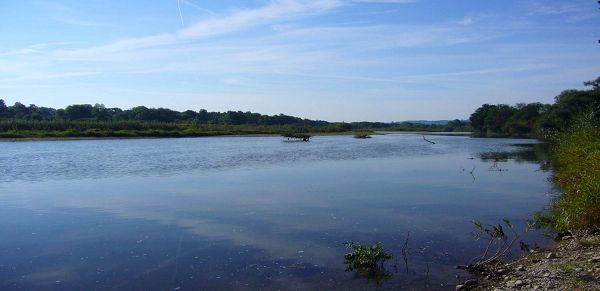Jun 15, 2017
Water is essential to life. We all rely on it for our daily uses and keeps us hydrated. What we know about our water is that it either came from a faucet or from water bottle labels. But there is so much to know about water that we cannot see. How can we measure the water contamination in the river water column? What contaminants in natural water can be deciphered? Do you know how pollutants such as metals (lead, zinc) can interact with suspended matter? In addition, we should consider how safe our water sources will be in the future. How can climate change can impact the heavy metals cycle in the aquatic environment?
Mathieu Le Meur sampling water in the Moselle River, France
Photo taken by Emmanuelle Montarges-Pelletier
My name is Mathieu Le Meur and I recently completed my PhD at the University of Lorraine, Nancy. My PhD aimed to better understand the spatial and temporal composition evolution of Suspended Particulate Matter (SPM) in the water column of the Moselle River, which is located in northeastern France and flows northward to Luxembourg and Germany. Different tributaries located downstream the study area were also selected for their high industrialized and urbanized catchment land use. This region in France is characterized by high legacy effects of industry that could affect the current status of water quality, in particular the SPM and sediment composition.
SPM are between 1 nm and 1 µm commonly described as including heterogeneous aggregates of organic matter, mineral fragments and microbiological fractions. They are very small in size and have really high surface area. In consequence, SPM can easily interact with various pollutants such as metal pollutants, organic compounds like pesticides, or microorganisms like bacteria. SPM can transport these materials with the water flow and may cause them to be chemically modified or released in the dissolved fraction.
Environmental scientists dealing with natural water use many techniques in order to better understand the composition of the SPM and, finally better understand the interactions between SPM and pollutants. The first step of the work is to go in the field and collect SPM. Several techniques can be used. One of the most powerful methods is the field flow centrifuge that permits the sampling of a huge amount of SPM (up to 100 g during storm conditions). In the lab, the next step is to analyze the particles in the samples.
First, we analyze the concentration of SPM in the water column. The size of the particles is also measured and this size also varies with the seasons and the water discharge. The second step is to better understand the mineralogy of SPM at the bulk scale, for that, we can use different techniques such as the X-ray diffraction (XRD), with this technique, we can define the different minerals. In order to get a finest understanding of SPM, we must use more powerful machine such as electronic microscopy. At this level, we can image a single particle and also, when the contamination is high, we can also have information concerning pollutants carriers (Le Meur et al. 2016). In my study, the SPM were rather similar concerning the mineralogical composition and only two tributaries showed strong contaminated SPM in relation with the impact of inherited steel making industrialization. The results also highlighted the contribution of the catchment geology in the SPM composition.
The SPM organic composition can also be analyzed using different molecular techniques. This scale of investigation is particularly suitable when dealing with SPM composition. Different organic compounds can be categorized such as fatty acids, sterols (like Cholesterol), polycyclic aromatic hydrocarbons (PAHs) or lignin (woody derivatives) compounds. These compounds can be used in order to better understand the different organic fluxes associated with SPM in the water column in relation with the regime flow and also the different seasons. For example, sterols such as Coprostanol can be used in order to trace anthropogenic contamination. These compounds can also be used in order to separate between the autochthonous production, directly formed in the water column such as the algae, and the allochthonous production, coming from the soils watershed and the river banks and released in the water column by leaching during storm events (Medeiros et al. 2012). These compounds can also inform on the freshness of the organic matter in SPM and in fine on the different sources of SPM during the different climatic conditions. In my study, the SPM organic composition was driven by the seasonal variations and a strong autochthonous production during the low flow level in summer (Le Meur et al. 2017).
When we investigated the mineral and organic composition, the next level is to better understand the interaction between SPM and contaminants. The first way is to analyze natural SPM with the natural contamination (in our case we decided to study the zinc as it is a common pollutant in the Moselle watershed). A very powerful way to access to the interaction is the use of X-ray absorption spectroscopy (XAS) experiments. This technique permit to get information concerning the local structure between the SPM and the contaminant at the atomic scale. This permit to get information concerning the different particles that can interact with contaminants and also to see if the interaction is strong or more labile. In the case of the Moselle River and the tributaries, the studies revealed the contribution of phyllosilicates (clay particles) in the zinc transport. In the environment, high level of Zn can cause microbial activity damage and also lead to phytotoxicity.
References:
Medeiros PM, Sikes EL, Thomas B, Freeman KH (2012) Flow discharge influences on input and transport of particulate and sedimentary organic carbon along a small temperate river. Geochimica et Cosmochimica Acta 77: 317-334.
Le Meur M, Montargès-Pelletier E, Bauer A, Gley R, Migot S, Barres O, Delus C, Villiéras F (2016) Characterization of suspended particulate matter in the Moselle River (Lorraine, France): evolution along the course of the river and in different hydrologic regimes. Journal of Soils and Sediments DOI 10.1007/s11368-015-1335-8
Le Meur M, Mansuy-Huault L, Lorgeoux C, Bauer A, Gley R, Vantelon D, Montargès-Pelletier E (2017) Spatial and temporal variations of Particulate Organic Matter from Moselle River and tributaries: A multimolecular investigation. Accepted for publication in: Organic Geochemistry.
Mathieu Le Meur sampling water in the Moselle River, France
Photo taken by Emmanuelle Montarges-Pelletier
A view of the Moselle River. Photo by Renaud Gley.
Field Flow Centrifuge used to collect Suspended Particulate Matter in water.
Water Chemistry Outreach / Education Research EDUCATION/OUTREACH
COMMENT ON "Adventures in the Critical Zone"
All comments are moderated. If you want to comment without logging in, select either the "Start/Join the discussion" box or a "Reply" link, then "Name", and finally, "I'd rather post as a guest" checkbox.
ABOUT THIS BLOG
Justin Richardson and his guests answer questions about the Critical Zone, synthesize CZ research, and meet folks working at the CZ observatories
General Disclaimer: Any opinions, findings, conclusions or recommendations presented in the above blog post are only those of the blog author and do not necessarily reflect the views of the U.S. CZO National Program or the National Science Foundation. For official information about NSF, visit www.nsf.gov.
Explore Further






